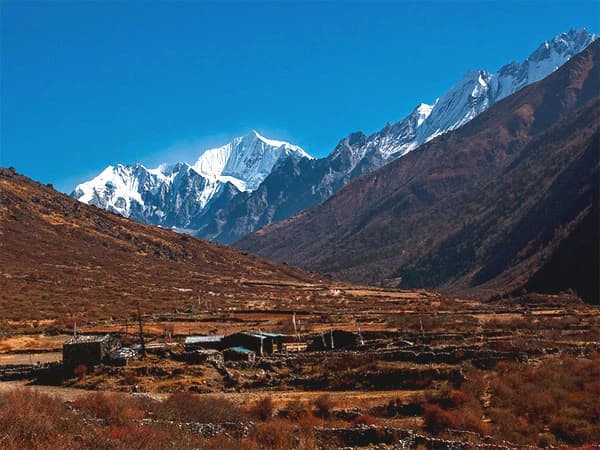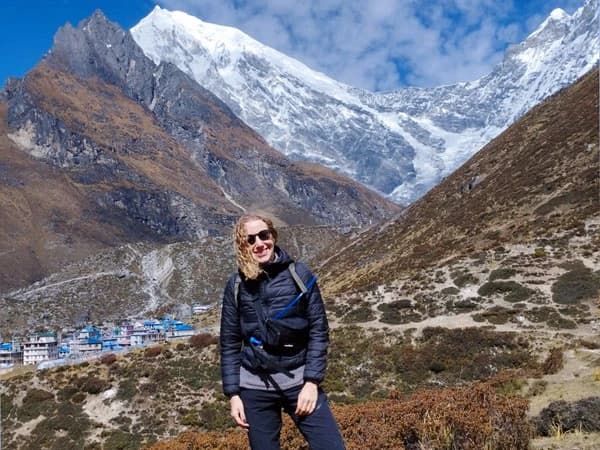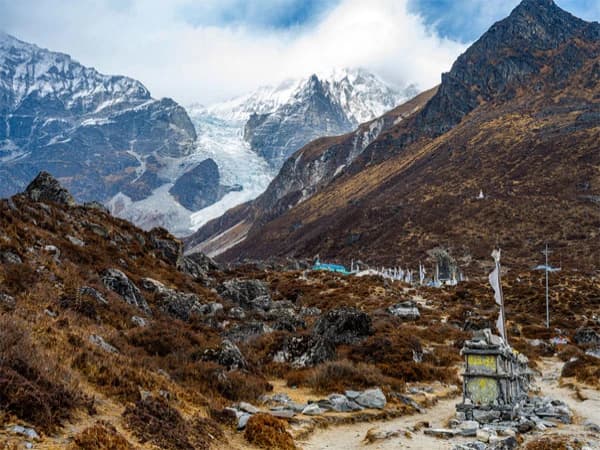1. Where is the Langtang Valley located?
Langtang Valley is situated within Langtang National Park, Rasuwa District, Nepal, approximately 122 km north of Kathmandu. It lies in the Central Himalayas and borders of the Chinese Tibetan Autonomous Region. The valley is oriented east-west and is bounded by white-cap peaks such as Langtang Lirung (7,234m). The place is renowned for the stunning alpine scenery, high biodiversity, and vibrant Tamang culture.
2. How long is the Langtang Valley Trek?
Standard Langtang Valley Trek typically takes 7-10 days, depending on side tour and trek route. One of the most popular itineraries is:
1-day road drive from Kathmandu to Syabrubesi
4-5 days walk to Kyanjin Gompa
1-2 days’ acclimatization and side trip to Kyanjin Ri or Tserko Ri
2 days' walk back
Optional trek: Side trips will add days to the trek by visiting the Gosainkunda Lake or Helambu region, creating a 14-17-day trek.
3. How hard is the Langtang Valley Trek?
The trek is classified as moderate, suitable for trekkers with basic fitness. There are no high passes or technical climbs, but the trail has several steep ascents and descents, especially from Lama Hotel to Langtang Village and beyond. You’ll reach elevations over 3,800 meters, which can cause altitude-related symptoms if not acclimatized properly. Expect 5–7 hours of walking daily.
4. How tall is the summit of the Langtang Valley Trek?
The highest point/summit of this trek is at Tserko Ri (4,984m / 16,350 ft). You can reach the Tserko Ri by a day hike from Kyanjin Gompa. Tserko Ri offers superb 360-degree views of Langtang Lirung, Dorje Lakpa, and Yala Peak to moraines and glaciers. Some trekkers also reach Kyanjin Ri (4,773m), which is slightly lower and easier.
5. When is the best time for Langtang Valley Trek?
Best time to trek the Langtang valley is during Spring and Autumn as Spring (March to May) offers Clear sky, rhododendron bloom forests, and good view. Whereas Autumn (September to November) brings Clear monsoon sky, painted landscape, and fine weather. Winter (Dec-Feb) offers serene trails and snowy landscapes but is bitterly cold at the higher elevations. Monsoon (June-Aug) must be avoided since it has slippery trails, leeches, landslides, and cloud-covered scenery.
6. Do I have to hire a porter and guide for Langtang Trek?
Yes, from 17 February 2025, as per the authorities of Langtang National Park, all trekkers are compulsory required to hire licensed guides in order to trek in Langtang region. It will boost security, elevate the trekking experience, and contribute to local economies. Porter is not necessary but definitely worth it if you have a heavy rucksack. Guides who know the path, customs, and emergencies, and porters take the physical strain away.
7. What permits are required for the Langtang Valley Trek?
You will have to obtain two compulsory permits:
- Langtang National Park Permit: The fee is NPR 3,000 (around USD 25) for foreigners, and NPR 1,500 for SAARC nationals.
- TIMS Card (Trekkers' Information Management System): Costs NPR 2,000 if issued through a trekking agency. As per the 2023 rules, it is only available through licensed agencies and must be obtained with a guide.
8. What are the accommodation facilities on the trek?
Langtang Valley is a teahouse trekking system with basic locally-owned lodges. They have twin-share beds, wood beds, foam mattress beds, and thick blankets. The communal toilet is generally open, and there is a small additional cost for hot showers (long-standing tradition, originally solar-heated). The majority of the lodges were rebuilt after the 2015 earthquake, particularly in Langtang Village and Kyanjin Gompa, and now boast better facilities than before.
9. What do I eat on the Langtang Trek?
Food is freshly prepared in teahouses; you will be eating food provided in the tea house like:
- Dal Bhat (lentils, rice, veg)
- Noodles, momo, fried rice, soups, pasta, pancakes, porridge
- Tibetan bread, potatoes, eggs, and occasional yak cheese at Kyanjin
Prices increase with altitude for transport cost. You will have to eat where you stay overnight so that local teahouses are supported.
10. How great is the risk of altitude sickness in Langtang?
The chances of Altitude sickness (Acute Mountain Sickness or AMS) is highly risky above 2,500 meters. Langtang Valley reaches 3,870m (Kyanjin) and potentially 4,984m (Tserko Ri), so headache, nausea, loss of appetite, and shortness of breath are likely. To minimize risk:
- Don’t ascend too quickly (no more than 500m a day above 3,000m)
- Drink plenty of fluid
- Take a rest/acclimatization day at Kyanjin
Drug treatment with drugs such as Diamox and rapid descent in the event of augmented symptoms is recommended.
11. Is the Langtang Valley Trek for Beginners?
Yes, Langtang Valley Trek is an excellent option for beginners in Nepal due to:
- Moderate difficulty
- Relatively lower elevation compared to Everest or Annapurna
- Slim time frame (7-10 days)
- Close proximity to Kathmandu
Regardless of that, some minimum physical condition and mental endurance are a prerequisite. Beginners should also arrange suitable equipment, rest days, and potentially hire a porter.
12. How do I get to the start of the Langtang Trek?
The trek begins from Syabrubesi village, about 122 km north of Kathmandu. You can reach trek start point in 7-8 hours’ drive from Kathmandu by jeep or bus (private/local). The road is bumpy and thin but beautiful with a hill, river, and small village view. There are daily public buses from Machhapokhari Bus Park (Gongabu Bus Park), near Balaju in Kathmandu.
13. Is Electricity and Internet Available during the Trek?
Yes, electricity and internet are available at most of the tea houses. The electronic gadgets are charged for NPR 100-300 an hour. Wi-Fi in most Langtang and Kyanjin lodges is operational, but it is slow and patchy. Mobile networks (NTC/Ncell) are functional in some pockets but patchily. Some limited 3G can be accessed with Ncell or NTC SIMs, primarily at lower elevations.
14. What should I take with me for the Langtang Valley Trek?
While going for the Langtang Valley Trek you should take layers of clothes to wear off moisture, insulating down jacket, waterproof shell, trekking pants, gloves, thermal socks, and hat. Broke-in trekking boots, sandals, pairs of woolen socks help a lot. Gears like Sleeping bag (rated -10°C or colder), trekking poles, headlamp, daypack, water bottle, purification tablets are crucial. Don’t forget to take items such as towel, pads and menstruation cups for ladies, sunscreen, lip balm, power bank, snacks, first-aid kit. Travel light but wisely and always remember, you may be carrying it or your porter will.
15. Is it safe to hike Langtang after the 2015 earthquake?
Yes, it is safe to hike Langtang as it has recovered very well since the most devastated earthquake in 2015. Due to international aid and dedication from local communities, new trails, teahouses, and infrastructure have been rebuilt. Langtang is not just safe but also friendly and revitalized today, and trekking here directly contributes to the livelihood of the locals and sustainable tourism.
Conclusion
The Langtang Valley Trek is a perfect combination of Himalayan adventures, natural beauty, and cultural richness. With moderate difficulty, comfortable tea houses and increasing accessibility, this trek is an ideal choice for solitude seeking trekkers. By understanding the given FAQS, preparing wisely, and respecting local customs and environment, you can make your Langtang journey a lifelong experience.





